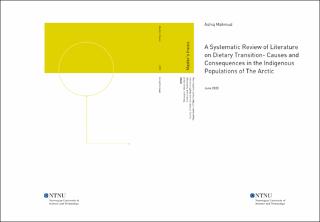| dc.description.abstract | Background: The traditional diet in the Arctic Indigenous populations have undergone a
significant transition. The Arctic Monitoring and Assessment Programme (AMAP) has been
looking into this dietary transition happening in the circumpolar earth for more than 20 years
from now and explained them through the studies focusing on changes in Arctic biodiversity,
human health, and natural environment. But there has not been any chapter explicitly focusing on
the transition of the food, diet, and nutritional status in the populations living in the Arctic.
Indigenous communities are the majority living in these demographics and their traditional food
habits have gone through a drastic change and hence affecting their health and lifestyle. This
study has focused on exploring the changes or transition in traditional food habits, diet, and
nutrition while identifying the causes and consequences to these changes in the indigenous
communities living in the Arctic regions through a systematic review of literature of the existing
valid evidence.
Methods: The study has been conducted through a systematic literature review including 91
literature (journals, books, reports, national surveys, articles, and unpublished manuscripts from
regional health experts and researchers) related to the topics Arctic indigenous food, diet,
nutrition, dietary transition, and traditional indigenous diet. Additional 5 literature was added to
formalize the method for the study. The relevant non-English pieces of literature were excluded
at first. Still, some of them have been included as the regional and native experts from AMAP
HHAG helped the study team with the English translation. The literature that did not match the
study objectives and keywords were excluded from the study. The references for the study have
been organized using Endnote 9X. For wording, citation and referencing APA 6th format has
been followed.
Results: A pattern of changes has been found in all indigenous and native populations residing
in the Arctic regions (Greenland, Scandinavia, Arctic Russia, Arctic Alaska, Arctic Canada)
caused by rapid globalization, gradual climate change, and inclusion of western diet. Traditional
diet was found more popular among the older generations than that was found in the younger
generations in the Arctic indigenous communities. It is found that the dietary changes have increased adverse health effects such as the increased prevalence of T2D, obesity, dental carries
and other metabolic diseases. On the positive side, these changes found beneficial in terms of
nutrient intake, as more vegetables have been included recently within the daily dietary
composition. However, the traditional diet is still considered as an integral part of the indigenous
cultures and traditions by all the Arctic indigenous populations. Rising concern regarding food
insecurity also has been found in the North American Arctic territories (Alaska and Canada) and
Arctic Russia which has been reported as one of the causes for the changes in the traditional diet,
besides other mentioned causes.
Conclusion: A similarity has been observed in dietary change patterns among all the Arctic
indigenous populations, which has both positive and negative consequences in terms of
populations’ health. Similarity has also been noted in terms of causes among the populations.
Globalization, climate change, and inclusion of western diet have been found as the common
causes for the overall traditional dietary patterns of the indigenous communities went and still
going through the transition. A rising concern in terms of food insecurity has also been found
mainly in Arctic Canada, Arctic Alaska, and Arctic Russia.
Keywords: Arctic traditional diet, Dietary Transition in the Arctic, Nutrition, Arctic Indigenous
Populations, Food Insecurity in Northern or Arctic Canada, Arctic Alaska, North and North-Western
Russia, Northern Norway, Sweden, Finland, Greenland. | |
